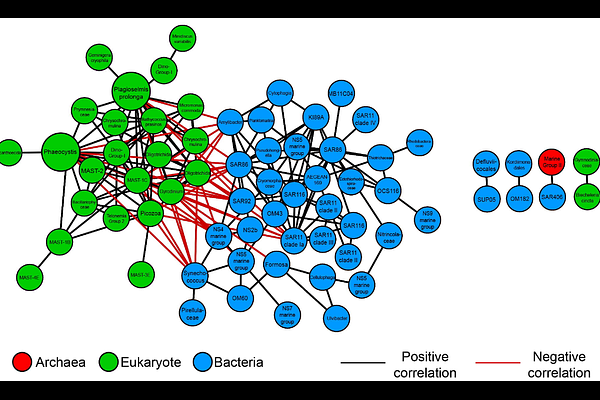Identifying potential keystone microbes from co-occurrence networks in the Gulf of Alaska

Identifying potential keystone microbes from co-occurrence networks in the Gulf of Alaska
Brauner, M.; Cohen, J.; Briggs, B. R.; Hennon, G. M. M.
AbstractThe Northern Gulf of Alaska (NGA) is a highly productive and diverse marine ecosystem. Differences in nutrient supply and physical circulation between nearshore and offshore waters in the NGA result in a mosaic of water masses with distinct biogeochemical signatures. We hypothesized that microbial communities in these regions not only differ in composition but also in the ecological interaction networks they support. We used amplicon sequencing of the 16S (V4) and 18S (V9) rRNA genes to characterize the microbial community differences between nearshore, continental shelf, and offshore regions in the NGA in summers 2018-2021. We observed significantly different community assemblages by region (MRPP, p = 0.001), with higher relative abundances and cell counts of heterotrophic bacteria and Synechococcus nearshore, elevated Alphaproteobacteria and SAR11 clades offshore, and greater dinoflagellates and Spirotrich ciliates on the shelf. Co-occurrence networks of operational taxonomic units (OTUs) of prokaryotes and eukaryotes were constructed for each region using statistically significant correlations (Spearman rank >0.8, Bonferroni corrected p < 0.05). Overall, the offshore network had higher centralization (0.331) and density (0.112), indicating higher connectivity and therefore more potential interactions compared to the shelf (0.191, 0.069) and nearshore (0.165, 0.041) networks. The nearshore network was characterized by higher proportions of potentially parasitic taxa such as Cryothecomonas aestivalis, Syndiniales Dino Group I, and MAST-1C and parasitoid bacteria Bdellovibrio and like organisms, suggesting that nearshore conditions may increase parasitoid/predator success through increased contact rates. Significant correlations between cryptophyte Plagioselmis prolonga and ciliate Oligotrichida were identified in all three regions, supporting previous findings that kleptoplasty is likely an important strategy across the NGA. Eukaryotic taxa that had the highest degree centrality across all three regions; P. prolonga and Phaeocystis are known to be mixotrophs, suggesting a role for bacterivory in forging a high number of interactions between protists and bacteria. Understanding these potential keystone microbes and their interactions is crucial for a greater understanding of ecosystem stability within the NGA.